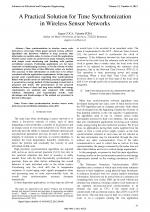| 4/2012 - 9 |
A Practical Solution for Time Synchronization in Wireless Sensor NetworksCOCA, E. |
| Extra paper information in |
| Click to see author's profile in |
| Download PDF |
Author keywords
time synchronization, wireless sensor node, network protocol, lifetime estimation, clock drift
References keywords
networks(28), sensor(26), time(15), synchronization(10), energy(10), protocol(8), network(7), link(6), communications(6), sensys(5)
Blue keywords are present in both the references section and the paper title.
About this article
Date of Publication: 2012-11-30
Volume 12, Issue 4, Year 2012, On page(s): 57 - 62
ISSN: 1582-7445, e-ISSN: 1844-7600
Digital Object Identifier: 10.4316/AECE.2012.04009
Web of Science Accession Number: 000312128400009
SCOPUS ID: 84872786088
Abstract
Time synchronization in wireless sensor node networks is a hot topic. Many papers present various software algorithms and hardware solutions to keep accurate time information on mobile nodes. In terms of real life applications wireless sensor nodes are preferred in many domains, starting with simple room monitoring and finishing with pipeline surveillance projects. Positioning applications are far more restrictive on timekeeping accuracy, as for the velocity of nodes calculations precise time or time difference values are needed. The accuracy of time information on nodes has to be always correlated with the application requirements. In this paper, we present some considerations regarding time synchronization linked with specific needs for individual practical applications. A practical low energy method of time keeping at node level is proposed and tested. The performances of the proposed solution in terms of short and long term stability and energy requirements are analyzed and compared with existing solutions. Simulation and experimental results, some advantages and disadvantages of the method are presented at the end of the paper. |
| References | | | Cited By |
Web of Science® Times Cited: 8 [View]
View record in Web of Science® [View]
View Related Records® [View]
Updated today
SCOPUS® Times Cited: 8
View record in SCOPUS® [Free preview]
View citations in SCOPUS® [Free preview]
[1] An Improved & Smart Clock Synchronisation Model for Emblematic IoT Applications, Upadhyay, Divya, Dubey, Ashwani Kumar, EAI Endorsed Transactions on Internet of Things, ISSN 2414-1399, Issue , 2025.
Digital Object Identifier: 10.4108/eetiot.5579 [CrossRef]
[2] Performance of clock sources and their influence on time synchronization in wireless sensor networks, Tirado-Andrés, Francisco, Araujo, Alvaro, International Journal of Distributed Sensor Networks, ISSN 1550-1477, Issue 9, Volume 15, 2019.
Digital Object Identifier: 10.1177/1550147719879372 [CrossRef]
[3] Active Frequency Stabilization Method for Sensitive Applications Operating in Variable Temperature Environments, DONE, A., CAILEAN, A.-M., GRAUR, A., Advances in Electrical and Computer Engineering, ISSN 1582-7445, Issue 1, Volume 18, 2018.
Digital Object Identifier: 10.4316/AECE.2018.01003 [CrossRef] [Full text]
[4] Wake-on-a-Schedule: Energy-aware Communication in Wi-Fi Networks, PERKOVIC, T., STANCIC, I., GARMA, T., Advances in Electrical and Computer Engineering, ISSN 1582-7445, Issue 1, Volume 14, 2014.
Digital Object Identifier: 10.4316/AECE.2014.01012 [CrossRef] [Full text]
[5] Social Networking of Instrumentation - a Case Study in Telematics, ROBU, D., SANDU, F., PETREUS, D., NEDELCU, A., BALICA, A., Advances in Electrical and Computer Engineering, ISSN 1582-7445, Issue 2, Volume 14, 2014.
Digital Object Identifier: 10.4316/AECE.2014.02024 [CrossRef] [Full text]
[6] Energy-efficient clustering method for wireless sensor networks using modified gravitational search algorithm, Ebrahimi Mood, Sepehr, Javidi, Mohammad Masoud, Evolving Systems, ISSN 1868-6478, Issue 4, Volume 11, 2020.
Digital Object Identifier: 10.1007/s12530-019-09264-x [CrossRef]
[7] An improved clock synchronization model for typical IoT applications, Upadhyay, Divya, Dubey, Ashwani Kumar, Engineering Research Express, ISSN 2631-8695, Issue 3, Volume 6, 2024.
Digital Object Identifier: 10.1088/2631-8695/ad65b6 [CrossRef]
Disclaimer: All information displayed above was retrieved by using remote connections to respective databases. For the best user experience, we update all data by using background processes, and use caches in order to reduce the load on the servers we retrieve the information from. As we have no control on the availability of the database servers and sometimes the Internet connectivity may be affected, we do not guarantee the information is correct or complete. For the most accurate data, please always consult the database sites directly. Some external links require authentication or an institutional subscription.
Web of Science® is a registered trademark of Clarivate Analytics, Scopus® is a registered trademark of Elsevier B.V., other product names, company names, brand names, trademarks and logos are the property of their respective owners.
Faculty of Electrical Engineering and Computer Science
Stefan cel Mare University of Suceava, Romania
All rights reserved: Advances in Electrical and Computer Engineering is a registered trademark of the Stefan cel Mare University of Suceava. No part of this publication may be reproduced, stored in a retrieval system, photocopied, recorded or archived, without the written permission from the Editor. When authors submit their papers for publication, they agree that the copyright for their article be transferred to the Faculty of Electrical Engineering and Computer Science, Stefan cel Mare University of Suceava, Romania, if and only if the articles are accepted for publication. The copyright covers the exclusive rights to reproduce and distribute the article, including reprints and translations.
Permission for other use: The copyright owner's consent does not extend to copying for general distribution, for promotion, for creating new works, or for resale. Specific written permission must be obtained from the Editor for such copying. Direct linking to files hosted on this website is strictly prohibited.
Disclaimer: Whilst every effort is made by the publishers and editorial board to see that no inaccurate or misleading data, opinions or statements appear in this journal, they wish to make it clear that all information and opinions formulated in the articles, as well as linguistic accuracy, are the sole responsibility of the author.



